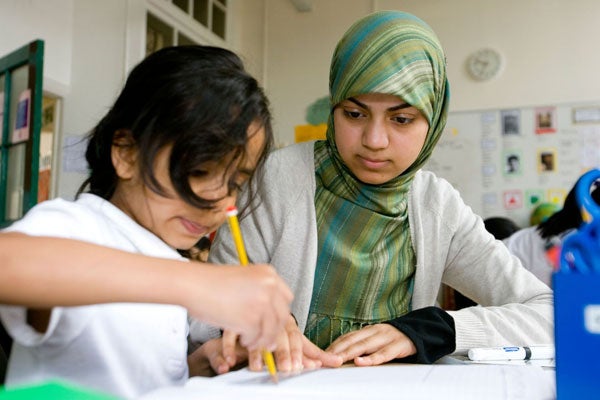Role model: Why teachers need to represent all parts of the community
Pupil performance and ambitions can be enhanced by appropriate role models.

However old we are, we remember plenty of our schoolteachers, and, for most of us in the UK, the colour of the faces we were taught by matched our own, which is still largely the case now. About 80 per cent of the school-age population is white, and more than 94 per cent of the teaching workforce is also white.
That means for the ethnic minority children in schools today, they are far more likely to be taught by someone from a different racial background to their own. Does this matter? The broad consensus in the education world is that it does.
"Having a diverse workforce is important to ensure that black and minority ethnic (BME) children benefit from being taught by a more balanced representation of the population," says Pav Akhtar, head of diversity at the Training and Development Agency for Schools (TDA), the Government body that oversees the training of teachers. "Having a more balanced teaching workforce can have a positive impact on pupil performance and aspiration among BME students," he adds.
But race isn't the only factor about which the TDA has concerns. "As well as trying to increase recruitment among BME heritage teachers, we would like to see more teachers with disabilities, and more male teachers in primary school," says Akhtar. "These are the three principal groups we are targeting."
One of the TDA's approaches to address this involves staff targeting extra advice to individuals from these groups when they make an initial inquiry about training for a school career. Teacher training institutions can also apply for TDA grants, of up to £20,000, for tailored programmes to attract and support applications from target groups.
But Akhtar stresses that none of this compromises the quality of recruits to the professions.
"What this does is target the enormous untapped quality that exists in many different communities, among people who are not yet considering teaching as a profession."
This approach is broadly welcomed by head teachers. Andrea Berkeley, now an education consultant, recently retired from her position as the head of Preston Manor high school in Wembley, after more than a decade at the helm. During that time, she transformed the school, where the majority of pupils are from ethnic minority backgrounds, from one which was judged by Ofsted to have serious weaknesses into one considered outstanding.
Her reshaping of the racial mix of the staff room was a factor in turning round the school.
"At the time, there was a big problem with African-Caribbean boys who were underperforming and causing disruption," she recalls. "So I had a specific initiative to look for black role models to work in the school, and this proved part of the solution."
However, Berkeley believes that these considerations do not outweigh the need to recruit good teachers.
That chimes with the view of Asghar Ali, 36, whose parents arrived from Pakistan in the Sixties, and who teaches at Montgomery Primary school in the Sparkbrook area of Birmingham, where the overwhelming majority of pupils are, like him, Muslim with Pakistani origins.
"While I do understand where the kids are coming from, and while they do see me in the community, at the mosque and at the shops, the main thing is that I am just their teacher and they see me as their teacher," he says.
He draws a parallel with his own experience in Birmingham schools during the Eighties. "I remember plenty of Asian teachers at my school in those days," he recalls. "But the teacher who actually had the greatest influence on me was a Mr Bolton, who was English."
Subscribe to Independent Premium to bookmark this article
Want to bookmark your favourite articles and stories to read or reference later? Start your Independent Premium subscription today.

Join our commenting forum
Join thought-provoking conversations, follow other Independent readers and see their replies